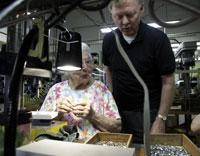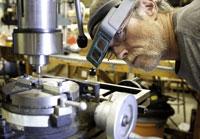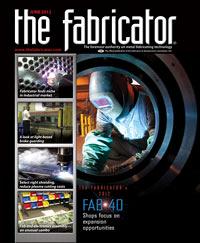Senior Editor
- FMA
- The Fabricator
- FABTECH
- Canadian Metalworking
Categories
- Additive Manufacturing
- Aluminum Welding
- Arc Welding
- Assembly and Joining
- Automation and Robotics
- Bending and Forming
- Consumables
- Cutting and Weld Prep
- Electric Vehicles
- En Español
- Finishing
- Hydroforming
- Laser Cutting
- Laser Welding
- Machining
- Manufacturing Software
- Materials Handling
- Metals/Materials
- Oxyfuel Cutting
- Plasma Cutting
- Power Tools
- Punching and Other Holemaking
- Roll Forming
- Safety
- Sawing
- Shearing
- Shop Management
- Testing and Measuring
- Tube and Pipe Fabrication
- Tube and Pipe Production
- Waterjet Cutting
Industry Directory
Webcasts
Podcasts
FAB 40
Advertise
Subscribe
Account Login
Search
The vitality of purposeful work
Tube and needle fabricator thrives with a unique workforce
- By Tim Heston
- June 15, 2012
- Article
- Shop Management
Metal fabricators and anthropologists don’t cross paths often, but then again, there aren’t many fabricators like Needham, Mass.-based Vita Needle, and there probably aren’t many anthropologists like Caitrin Lynch, Ph.D., associate professor at the nearby Olin College of Engineering.
Lynch spent five years studying the stainless steel tubing and needle manufacturer, working on the assembly line, immersing herself in the business and its culture. And it wasn’t to learn about the latest tube fabrication techniques or the idiosyncrasies of the needle industry. Instead, she came to study a unique workforce. The median age of a Vita Needle employee is 73.
The company practices what Lynch calls eldersourcing, something she writes extensively about in her new book, Retirement on the Line. She argues that the retired too often are lumped into one demographic, a group that supposedly slides out of productive society gracefully, ready to embrace a long-awaited life of leisure.
But it’s not that simple. Nowadays people live decades into retirement, and not everyone wants to spend all that time unemployed. People in their 70s can be quite different from people in their 90s, just as people in their 40s can be quite different from people in their 60s. At Vita, older workers socialize, joke, and have a sense of belonging, all qualities of more traditional retiree pursuits like hobbyist clubs and volunteer groups. But as Lynch explained, employment has a unique value; no matter their age, employed people can feel they’re part of a communal purpose.
This holds true even for Rosa Finnegan, Vita Needle’s oldest employee, a centenarian. She started at Vita as a youthful 85-year-old. “When I see her work,” Lynch said, “it makes me feel alive.”
After several years at the company, the professor began to realize how important purposeful work can be to a person’s identity. “Some employees start later in their retirement, sometimes after a spouse passes away. They were caregiving for a loved one. Some have said, ‘My purpose in life was to take care of my wife, and when my wife passed away, I had no purpose anymore. I came here, and my co-workers really helped keep me alive.’”
Vita Needle’s elderly employees don’t work 60-hour weeks. Most are part-time, about 20 hours a week, and are offered flexible work schedules. If they want to take off for a month for a cross-country trip in the summer, they usually can. The market hasn’t been kind to nest eggs in recent years, so some work because they need the money. But for most, money isn’t the only reason.
Today Vita Needle employs 49 people, and about 20 are younger, full-time employees; the rest are part-time, and most of them are 65 or older. Managers didn’t start hiring the elderly as part of some grand plan, as Director of Marketing and Engineering Frederick Hartman II explained. “In the late 1980s and early 1990s, we were looking to add more people to the workforce here. At the time the only people available locally who were interested in working in a factory were senior citizens. So we hired them, and we discovered the approach was effective for a variety of reasons.
“We’ve got a crew that’s very loyal,” Hartman continued. “They want to be here. And it certainly works well for us because of the type of business we’re in. We’re more concerned with quality than with the quantity of output.”
From a business perspective, employing the elderly has some obvious advantages. They qualify for Medicare, for one thing, and because so many work part-time, the company can schedule its workforce to match the ebb and flow of customer demand.
But the practice also has some less obvious benefits that suit manufacturing especially. About a third of the older workers have manufacturing experience; they work alongside the younger generation and pass their knowledge on.
Hartman recalled a story about an older tooling specialist who helped a younger worker design a die to form a 90-degree flange in extremely thin-walled tubing, without fracturing it. “This all required knowing the correct speed and angle [of the tool], and that knowledge comes from experience. You can’t learn that from a book or a computer screen.”
Eldersourcing also helps Vita Needle’s employee retention. Small businesses employ most Americans, including most metal fabricators. If you weld, cut, or form metal for a living, chances are you work for a small company. But small companies also have pyramid structures with plenty of room at the bottom and less room in the middle and top. If someone starts his career at the bottom and wants to move up the ladder in a small company, he or she often not only has to work hard but also be in the right place at the right time. If a supervisor or senior manager isn’t going anywhere, the ambitious employee probably will jump ship and find another (and often larger) company with better pay and potentially a career ladder to climb. This is a perennial challenge for thousands of small metal fabrication businesses across the country, and often no one is to blame. A small company can have only so many generals.
But Vita Needle doesn’t have this problem. If someone starts working there at 70, it’s very likely he’ll stay on for a decade or even more. “And they aren’t looking to climb the corporate ladder,” Hartman said. “We don’t have a lot of turnover, so we aren’t hunting for people often.” Many may work seemingly mundane assembly jobs, but they’re engaged, they show up on time, and they brainstorm better ways to get the job done.
Eldersourcing wouldn’t work for many fabricators, of course. Not many retirees would want to spend their days hauling large, heavy workpieces to this press brake or that shear. But as Hartman explained, for small-part, precision manufacturing—Vita Needle’s niche—the elderly can fulfill a business need.
Industry analysts fret about the graying American workforce, especially in the skilled trades. But just because people turn 65 doesn’t mean they become useless or separate from the working world entirely, never to talk of their skilled trade again. In fact, when it comes to job knowledge, older workers may become one of metal fabrication’s greatest assets.
About the Author

Tim Heston
2135 Point Blvd
Elgin, IL 60123
815-381-1314
Tim Heston, The Fabricator's senior editor, has covered the metal fabrication industry since 1998, starting his career at the American Welding Society's Welding Journal. Since then he has covered the full range of metal fabrication processes, from stamping, bending, and cutting to grinding and polishing. He joined The Fabricator's staff in October 2007.
subscribe now

The Fabricator is North America's leading magazine for the metal forming and fabricating industry. The magazine delivers the news, technical articles, and case histories that enable fabricators to do their jobs more efficiently. The Fabricator has served the industry since 1970.
start your free subscription- Stay connected from anywhere

Easily access valuable industry resources now with full access to the digital edition of The Fabricator.

Easily access valuable industry resources now with full access to the digital edition of The Welder.

Easily access valuable industry resources now with full access to the digital edition of The Tube and Pipe Journal.
- Podcasting
- Podcast:
- The Fabricator Podcast
- Published:
- 04/16/2024
- Running Time:
- 63:29
In this episode of The Fabricator Podcast, Caleb Chamberlain, co-founder and CEO of OSH Cut, discusses his company’s...
- Trending Articles
AI, machine learning, and the future of metal fabrication

Employee ownership: The best way to ensure engagement

Steel industry reacts to Nucor’s new weekly published HRC price

Dynamic Metal blossoms with each passing year

Metal fabrication management: A guide for new supervisors

- Industry Events
16th Annual Safety Conference
- April 30 - May 1, 2024
- Elgin,
Pipe and Tube Conference
- May 21 - 22, 2024
- Omaha, NE
World-Class Roll Forming Workshop
- June 5 - 6, 2024
- Louisville, KY
Advanced Laser Application Workshop
- June 25 - 27, 2024
- Novi, MI





























